Research and Analysis of Evaluation and Expansion of Physical Education Teaching System Based on Internet of Things Communication
Abstract
Under the influence of China’s education reform, the assessment and evaluation of physical education have gradually attracted more and more people’s attention. Teaching evaluation ignores the development of students’ sports lifestyle. The article uses principal component analysis to establish a teaching quality evaluation model and design an extensible teaching evaluation system. The article uses box plots to reflect the characteristics of data changes, which can clearly draw differences between samples. Three variables of experimental class, reference class, and standard class are set up to conduct controlled experiments, and statistics are made from the survey results of the 2018-2019 school year physical education evaluation student evaluation. The experimental results indicate that after using the system, students’ learning satisfaction and enthusiasm have been greatly increased, and students’ weekly exercise time and sports items have also increased. Before and after the use of the teaching evaluation system, the students’ satisfaction with the evaluation system and the degree of movement recognition were tested. The results show that the system has a positive effect on the students’ evaluation satisfaction and movement recognition.
1. Introduction
As the degree of informatization of physical education continues to deepen, attention is gradually being paid to the assessment and evaluation of physical education. The article proposes an expanded physical education teacher assessment and evaluation system. Literature [1] applies the analytic hierarchy process to establish a system of the physical education curriculum evaluation system and conduct empirical analysis, constructing an evaluation index system composed of 5 one-level indicators and 13 second-level indicators. In this practical operation, we can find that the system can clearly reflect the learning situation of college students for PE course selection, and the model can also be empirically analyzed. The system has strong operability. In the literature [2], interviews, evaluations, and tests, it is believed that the index has high reliability, validity, and easy-to-use characteristics, and it provides a scientific basis for physical education teaching. Literature [3] explained the necessity of including physical education into the college entrance examination system from different aspects; the article analyzed the importance of physical education and believed that including sports into the college entrance examination is a plan proposed by the system of caring for students, and it can also improve the importance of physical education. Literature [4] established a new event physical education teaching and curriculum evaluation based on the principles and methods of sociological statistics; this paper applies the established curriculum evaluation system to offline teaching practice, evaluates this emerging event, and explores the necessity of building a classroom curriculum evaluation system. According to the research results, the evaluation method has a great promotion effect on the course teaching and has a broad prospect for development. Through investigation and statistics, a comprehensive analysis of the intelligence method, literature [5] established a comprehensive evaluation index system according to the ability, quality, and knowledge structure of physical education teachers. In order to accurately evaluate the performance of faculty and staff, an effective evaluation system is essential. The literature [6] is investigating the status quo of the evaluation of teachers of physical education departments in American universities and colleges for providing analysis for an effective evaluation system. The research results show that the experimental results prove that not only can provide accurate information but also explore how the respondents view the important types of information used in the current teacher evaluation system. Literature [7] combined fuzzy mathematics decision-making with the MBO performance evaluation system in management theory and constructed a reasonable model of the performance. Based on the design model, the article uses analysis and evaluation methods to comprehensively evaluate performance and provides a reference for teacher evaluation. Literature [8] studied the theoretical basis of the practical ability evaluation system of physical education students in normal colleges, the determination of evaluation weights, the formulation of evaluation standards, and the evaluation of practical ability. The research has a great role in promoting the establishment of the evaluation system of college students. General physical education evaluation is organized by the school’s leaders, ignoring the importance and particularity of physical education, and selecting methods similar to other courses for curriculum evaluation; literature [9] relies on students and colleagues, quantitative analysis combined with quantitative statistics. In order to objectively, comprehensively, and truly reflect the present situation and effect of physical education, a university should have a practical teaching quality evaluation system, which is the basis for guaranteeing teaching quality. It is particularly important to establish a successful teaching quality evaluation system; literature [10] uses the analytic hierarchy process to establish a physical education teacher’s teaching quality indicator system, and the distribution of weights can provide a scientific basis for constructing the quality evaluation system of college physical education teachers. The article analyzes many aspects of pedagogy [11], investigates a large amount of data, and analyzes the status quo of teaching evaluation in a university in Xi’an. Literature [12] constructed a teaching evaluation index system for the sports major; the author analyzed the education ratings of professionals in the education field and constructed a teaching evaluation index system for the sports industry. Literature [13] uses fuzzy mathematics to develop physical education teaching and evaluation of curriculum application. The educational quality evaluation of colleges and universities is a huge project. The system can directly reflect the teaching quality of schools and also provides reliable information for the Ministry of Education. Literature [14] proposes that education reform has triggered an extensive process of research, restoration, systematization, and reorganization of the education system and has resulted in profound changes in the conceptual field. Literature [15] is the basis for the systematic analysis of the connotation and characteristics of school sports policy execution above. The system includes individuals and organizations, which are divided into multiple indicators to meet the school’s teaching evaluation tasks. Different literatures are put forward to analyze different teaching classes. From the above literatures, different research points can be reflected to analyze the relevance of the index system structure. It also reflects the fairness and impartiality of the evaluation system and can provide practical guidance for different teaching applications.
2. Research Status
2.1. The Evaluation of the Physical Education System
2.1.1. Sports Assessment Method
At present, many school physical examination and evaluation methods are carried out by filling in offline paper questionnaires and electronic forms. The school evaluation management staff will send the paper forms to the students, and the students will fill in according to their own opinions. And then, the staff will count and summarize the collected data and then get the final result. The statistical data is relatively large, the calculation is not convenient, and the statistical results will have some artificial errors. Based on these problems, some colleges and universities have established a teaching evaluation system. Compared with traditional evaluation methods, the calculation results are accurate, and work efficiency has been greatly improved. However, the system also has some shortcomings because of the particularity of certain courses. The evaluation of such courses lacks flexibility, which will also be improved for network technology.
2.1.2. Assessment Status Analysis
Because of the inflexibility of the system, the assessment and evaluation of some courses are still in manual operation, lacking a complete set of information technology to support the evaluation work, and the teachers present an independent and decentralized way and lack a unified set of information.
2.2. The Internet of Things Establishes the Conditions for the Construction of the System
2.2.1. The Current Progress of College Informatization Construction
As we all know, in the development process of colleges and universities, informatization construction has undergone initial hardware construction, network construction, and transition to application construction and service construction. It has transitioned from independent and partial construction to overall and overall construction. Therefore, under the impetus of this process, we are engaged in the department of physical education assessment, and evaluation will naturally think about the use of current information technology to realize its needs for assessment and evaluation.
2.2.2. IT Technology Drive at the Current Stage
At present, IT technology in information technology is changing with each passing day, especially with the mobile Internet and the IoT; some application framework technologies are emerging in an endless stream [16]. NET framework, Java’s SSH MVC framework, Wabacus, Jquery framework, etc., and some advanced development environments such as Delphi XE7, MyEclipse, VS.NET, and Android provide more feasibility and convenience for technical implementation. In the construction process, the above has also been greatly improved than before. Driven by this series of advanced technologies, informatization builders can better control the construction process in accordance with actual needs.
The application of corresponding technical means is to realize the fairness and objectivity of teaching quality evaluation in this paper. In the specific function realization, the system design and optimization can be realized by using the above technology.
2.3. Significance of the Assessment System
Most assessment and evaluation systems themselves have certain similarities and commonalities. Under the conditions of meeting actual needs, these similar and common functions are encapsulated into an independent functional module, and then, the relationship between various levels is established from an overall perspective. As well as the functional logic within the hierarchy, the design helps to establish a relatively open and universal information system.
3. Method
3.1. Physical Education Evaluation Method
Can get parameters Xi(i = 1, 2, 3 ⋯ p).
In this which, Wj is the J weight value.
3.2. Teaching Quality Evaluation Model
3.2.1. Comparison of Professional Modules
We use box plots to reflect the characteristics of the data distribution. There are six numerical features [21], as shown in Figure 1.
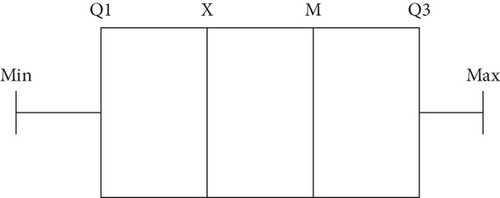
3.2.2. Module Comparison
4. Experimental Part
4.1. Experimental Comparison Results
Using the teaching evaluation system, we conducted a school year of teaching practice. We set up three variables of experimental class, reference class, and standard class to conduct comparative experiments. We conducted statistics from the results of the 2018-2019 school year physical education evaluation student evaluation survey results. In the article, the indexes of teaching attitude, teaching ability, teaching content, teaching method, and teaching effect are comprehensively applied, and the students’ application time, the number of items, and the intensity of exercise are compared. The paper is also divided into reference class, experimental class, and standard class for comparison. The results show that the application of these indicators plays an important role.
The specific situation is as follows. Table 1 is shown; the statistical diagram is shown in Figure 2.
| Class | Attitude | Ability | Content | Method | Effect |
|---|---|---|---|---|---|
| Reference class | 21.45 | 17.09 | 12.85 | 17.11 | 17.11 |
| Experimental class | 21.8 | 17.38 | 13.09 | 17.43 | 17.47 |
| Standard class | 20.7 | 17.11 | 12.5 | 17.08 | 17.01 |
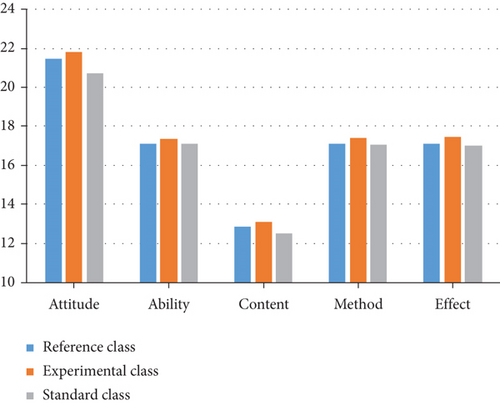
From Figure 2, we can see that the students in our test are more satisfied with their teachers than the reference class and standard class. Most students give the system a higher evaluation; the system has adjusted and adjusted the previous teaching methods. Compared with the previous teaching method, students’ interest in learning has shown a substantial increase; we have conducted a survey of students’ weekly exercise. The specific situation is shown in Table 2, and the statistical chart is shown in Figure 3.
| Class | Student exercise time (hour) | Number of student exercise items (a) | Student exercise intensity (level) |
|---|---|---|---|
| Reference class | 6.95 | 8.12 | 4 |
| Experimental class | 4.8 | 6.5 | 3 |
| Standard class | 5.0 | 7.1 | 2 |
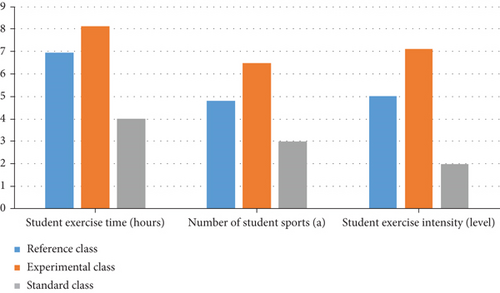
From Figure 3, we can see that the students’ exercise time and sports items have been increased by four, which helps the students to form the consciousness of physical exercise in the subconscious.
4.2. System Test
We tested the average response time and query time of the system and their success rate and set up three modes of intelligent optimization, custom development, and platform development for comparison experiments. The specific conditions are shown in Table 3.
| System | Number of requests | 3000 | 3500 | 4000 | 4500 | 5000 | 5500 | 6000 |
|---|---|---|---|---|---|---|---|---|
| Internet of Things system | Average response time | 33 | 45 | 55 | 95 | 135 | 205 | 279 |
| Success rate (%) | 100 | 100 | 100 | 100 | 100 | 100 | 100 | |
| Custom development model | Average response time | 40 | 55 | 86 | 180 | 250 | 420 | 500 |
| Success rate (%) | 100 | 99.6 | 99.5 | 99.4 | 99.3 | 98.4 | 99.3 | |
| Platform development model | Average response time | 53 | 65 | 100 | 220 | 420 | 460 | 550 |
| Success rate (%) | 100 | 98.6 | 98.5 | 98.4 | 98.3 | 98.2 | 98 |
From Figures 4 and 5, we can get that, compared with the other two modes. The system with intelligent optimization method has obvious advantages in average response time and query efficiency. In concurrent multitasking, the average response time will increase, but the success rate will decrease.
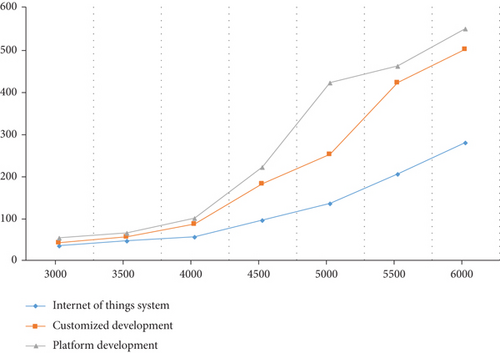
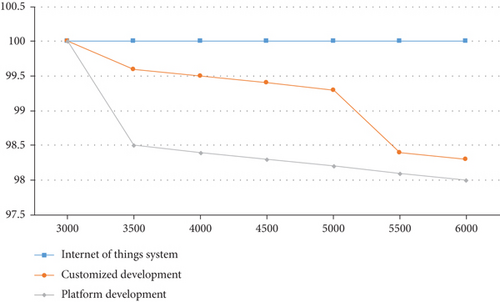
The test parameters of multitasking capability of Internet of Things system are shown in Table 4 and Figures 6 and 7.
| System | Number of requests | 90 | 120 | 150 | 180 | 210 | 240 | 270 |
|---|---|---|---|---|---|---|---|---|
| Internet of Things system | Average response time | 85 | 290 | 350 | 450 | 600 | 800 | 920 |
| Success rate (%) | 100 | 100 | 100 | 100 | 100 | 100 | 100 | |
| Custom development model | Average response time | 105 | 300 | 430 | 550 | 750 | 1150 | 1500 |
| Success rate (%) | 100 | 99.6 | 99.5 | 99.4 | 99.3 | 99.2 | 99.1 | |
| Platform development model | Average response time | 160 | 260 | 500 | 600 | 900 | 1400 | 1700 |
| Success rate (%) | 99.7 | 99.5 | 99.4 | 99.3 | 99.2 | 99.1 | 99.0 |
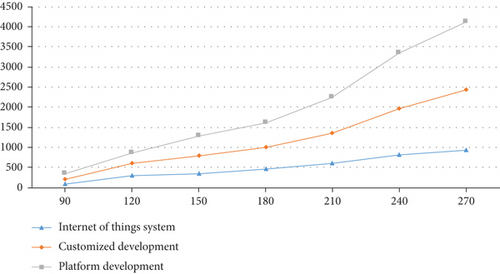
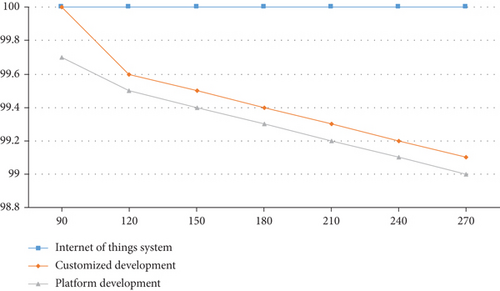
In the experimental part of the article, the system is tested. From the experimental results, the system with intelligent optimization scheme has lower response time and higher success rate. From the point of view of system complexity, the time complexity of intelligent optimization scheme is n∗log(n), while the other two schemes are n2 and n3, which have higher time complexity. As far as the overall performance is concerned, the intelligent optimization system has higher performance and better complexity.
4.3. Extended Research Analysis
This experiment tested the students’ satisfaction with the evaluation system and their knowledge of actions after using the teaching evaluation system. Three variables were set up: the experimental group, the control group, and the basic group. The specific experimental conditions are shown in Figures 8 and 9.
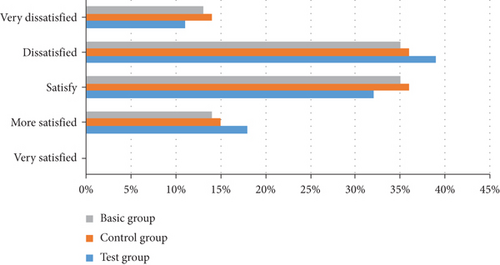
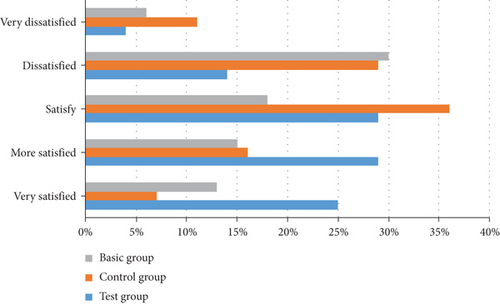
From Figures 8 and 9, we can see that the students’ satisfaction with the three groups of variables has increased to a certain extent after using the system. Among them, the satisfaction of the experimental group has been greatly improved, and the dissatisfaction has been greatly improved. The experimental results show that the teaching evaluation system can improve students’ summative evaluation of conventional teaching methods, and they have great satisfaction with the evaluation system.
From Figures 10 and 11, we can see that there is no significant difference in motor cognition among the students in the first three groups without using the teaching evaluation system. After using the system, there is a significant difference in motor cognition. The situation in the experimental group is more significant.
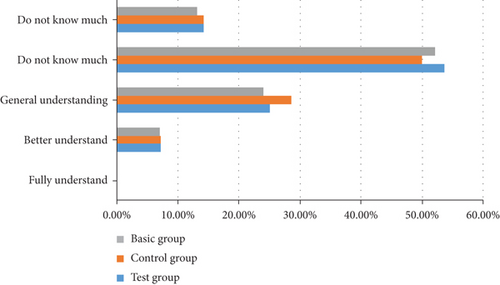
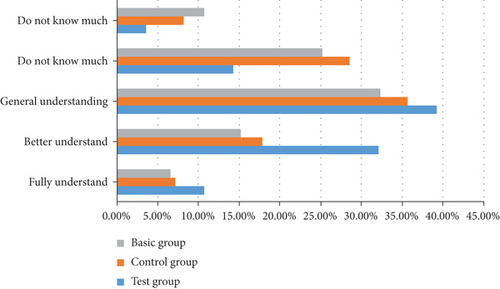
5. Conclusion
In short, the evaluation of physical education is an important link in the process of school physical education and plays an important role in constructing a complete and effective teaching process. Whether the establishment of physical teaching principles is reasonable, whether students’ learning behaviors are correct, and whether the teaching effect is excellent must be confirmed by the evaluation of physical education teachers. To this end, teachers should actively study the evaluation strategy of physical education classroom teaching to give full play to the evaluation function of classroom teaching, mobilize the enthusiasm of students to participate in sports, to enhance the effectiveness and quality of school physical education, improve students’ physical fitness, and lay a solid foundation for students’ development. More attention should be given to classroom teaching evaluation to achieve a comprehensive evaluation of teachers and students, and on this basis, enrich teaching methods, and provide schools with better quality physical education classroom teaching.
Conflicts of Interest
The authors declared that they have no conflicts of interest regarding this work.
Acknowledgments
This work was supported by the Key Scientific Research Project of Hunan Provincial Department of Education in 2018 (Project No.: 18A469).
Open Research
Data Availability
The experimental data used to support the findings of this study are available from the corresponding author upon request.




